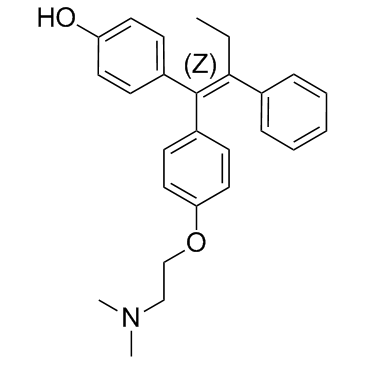4-hydroxytamoxifen

4-hydroxytamoxifen structure
|
Common Name | 4-hydroxytamoxifen | ||
|---|---|---|---|---|
| CAS Number | 68047-06-3 | Molecular Weight | 387.514 | |
| Density | 1.1±0.1 g/cm3 | Boiling Point | 514.4±50.0 °C at 760 mmHg | |
| Molecular Formula | C26H29NO2 | Melting Point | 105-107ºC | |
| MSDS | Chinese USA | Flash Point | 264.9±30.1 °C | |
| Symbol |


GHS07, GHS08 |
Signal Word | Warning | |
|
Inhibitory mechanism of FAT4 gene expression in response to actin dynamics during Src-induced carcinogenesis.
PLoS ONE 10(2) , e0118336, (2015) Oncogenic transformation is characterized by morphological changes resulting from alterations in actin dynamics and adhesive activities. Emerging evidence suggests that the protocadherin FAT4 acts as a tumor suppressor in humans, and reduced FAT4 gene express... |
|
|
Cheminformatics analysis of assertions mined from literature that describe drug-induced liver injury in different species.
Chem. Res. Toxicol. 23 , 171-83, (2010) Drug-induced liver injury is one of the main causes of drug attrition. The ability to predict the liver effects of drug candidates from their chemical structures is critical to help guide experimental drug discovery projects toward safer medicines. In this st... |
|
|
Impact of induced fit on ligand binding to the androgen receptor: a multidimensional QSAR study to predict endocrine-disrupting effects of environmental chemicals.
J. Med. Chem. 48 , 5666-74, (2005) We investigated the influence of induced fit of the androgen receptor binding pocket on free energies of ligand binding. On the basis of a novel alignment procedure using flexible docking, molecular dynamics simulations, and linear-interaction energy analysis... |
|
|
The generation and characterization of novel Col1a1FRT-Cre-ER-T2-FRT and Col1a1FRT-STOP-FRT-Cre-ER-T2 mice for sequential mutagenesis.
Dis. Model Mech. 8 , 1155-66, (2015) Novel genetically engineered mouse models using the Cre-loxP or the Flp-FRT systems have generated useful reagents to manipulate the mouse genome in a temporally-regulated and tissue-specific manner. By incorporating a constitutive Cre driver line into a mous... |
|
|
The histone H2A deubiquitinase Usp16 regulates embryonic stem cell gene expression and lineage commitment.
Nat. Commun. 5 , 3818, (2014) Polycomb Repressive Complex 1 and histone H2A ubiquitination (ubH2A) contribute to embryonic stem cell (ESC) pluripotency by repressing lineage-specific gene expression. However, whether active deubiquitination co-regulates ubH2A levels in ESCs and during dif... |
|
|
Critical roles for nitric oxide and ERK in the completion of prosurvival autophagy in 4OHTAM-treated estrogen receptor-positive breast cancer cells.
Cancer Lett. 353(2) , 290-300, (2014) Autophagy is a mechanism of tamoxifen (TAM) resistance in ER-positive (ER+) breast cancer cells. In this study, we showed in ER+ MCF7 cells that 4-hydroxytamoxifen (4OHTAM) induced cellular nitric oxide (NO) that negatively regulates cellular superoxide (O2-)... |
|
|
Mouse Rif1 is a key regulator of the replication-timing programme in mammalian cells.
EMBO J. 31(18) , 3678-90, (2012) The eukaryotic genome is replicated according to a specific spatio-temporal programme. However, little is known about both its molecular control and biological significance. Here, we identify mouse Rif1 as a key player in the regulation of DNA replication tim... |
|
|
Identification of gene regulation patterns underlying both oestrogen- and tamoxifen-stimulated cell growth through global gene expression profiling in breast cancer cells.
Eur. J. Cancer 50(16) , 2877-86, (2014) A c-Src inhibitor blocks oestrogen (E2)-induced stress and converts E2 responses from inducing apoptosis to growth stimulation in E2-deprived breast cancer cells. A reprogrammed cell line, MCF-7:PF, results in a functional oestrogen receptor (ER). We addresse... |
|
|
The effects of endoxifen and other major metabolites of tamoxifen on the sulfation of estradiol catalyzed by human cytosolic sulfotransferases hSULT1E1 and hSULT1A1*1.
Drug Metab. Dispos. 43 , 843-50, (2015) Tamoxifen is successfully used for both treatment and prevention of estrogen-dependent breast cancer, yet side effects and development of resistance remain problematic. Endoxifen is a major active metabolite of tamoxifen that is being investigated for clinica... |
|
|
Virtual and biomolecular screening converge on a selective agonist for GPR30.
Nat. Chem. Biol. 2 , 207-12, (2006) Estrogen is a hormone critical in the development, normal physiology and pathophysiology of numerous human tissues. The effects of estrogen have traditionally been solely ascribed to estrogen receptor alpha (ERalpha) and more recently ERbeta, members of the s... |